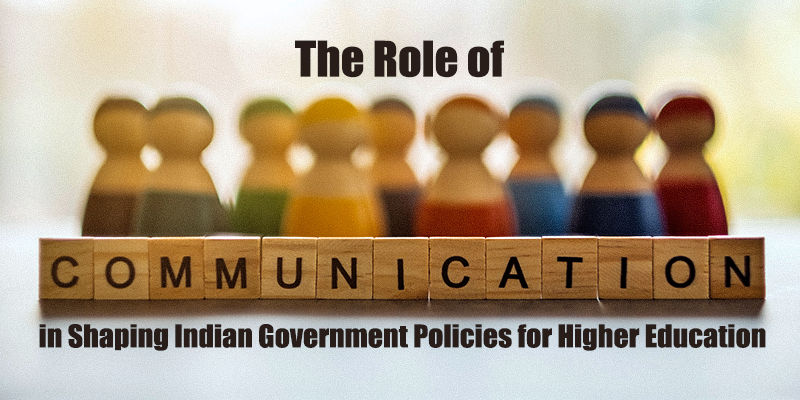Editor’s Note
Prof. Amrita Mitra Mukherjee is a seasoned communication professional who has also been teaching Media Academics, Business Communication, and Corporate Training. She also holds an LLB degree and is registered with the Bar Council of India. In the span of her 18+ years of academic career, Prof. Mukherjee has worked at length as a faculty of Media and Communication with leading institutions in the country. Fluent in English, Bengali, and Hindi, she has been an effortlessly skilled communicator and mentor and has proven her mettle in both academics and corporate training. Her corporate training has ranged from organizations like Nestle, L&T, DRAUP, etc., to taking up training associations with different Government projects.
Communication plays a pivotal role in shaping government policies for higher education in India, influencing both the formulation and implementation of these policies. The dynamic interplay between various stakeholders—government bodies, educational institutions, students, and the public—highlights the necessity of effective communication strategies in addressing the multifaceted challenges faced by the higher education sector.
Stakeholder Dialogue
At the core of policy development is the need for dialogue among stakeholders. The Indian government, recognizing the importance of higher education in national development, has initiated various programs aimed at enhancing access, quality, and relevance of higher education. Effective communication channels facilitate the dissemination of information regarding these initiatives, ensuring that all stakeholders are informed and engaged. For instance, the National Institutional Ranking Framework (NIRF) serves as a communication tool that not only ranks institutions but also encourages them to improve their standards based on feedback and performance metrics.
Bridging Policymakers and Academia
Moreover, communication serves as a bridge between policymakers and the academic community. Regular consultations, workshops, and seminars allow educators and researchers to voice their concerns and suggestions, thereby influencing policy decisions. This participatory approach fosters a sense of ownership among stakeholders, leading to more effective implementation of policies. The inclusion of diverse voices in the policy-making process ensures that the resultant frameworks are not only comprehensive but also reflective of the needs of the society they aim to serve.
Media Influence
The role of media in shaping public perception and discourse around higher education policies cannot be overstated. Media coverage of educational issues, such as access to quality education, funding challenges, and the employability of graduates, plays a crucial role in informing public opinion and influencing government action. Investigative journalism and opinion pieces can highlight gaps in the system, prompting policymakers to respond proactively. Furthermore, social media platforms have emerged as powerful tools for advocacy, enabling students and educators to mobilize support for reforms and to hold the government accountable.
Digital Communication Transformation
In addition to traditional media, the rise of digital communication has transformed the landscape of higher education policy discourse. Online platforms facilitate real-time discussions and feedback, allowing for a more agile response to emerging challenges. For instance, during the COVID-19 pandemic, the rapid shift to online learning necessitated immediate policy adaptations. The government’s ability to communicate effectively with educational institutions and students regarding new guidelines and support measures was crucial in navigating this unprecedented situation.
Challenges in Communication
However, challenges remain in the realm of communication within the higher education sector. Bureaucratic hurdles, lack of transparency, and inadequate feedback mechanisms can hinder effective dialogue between the government and educational institutions. To address these issues, there is a pressing need for the establishment of robust communication frameworks that prioritize transparency and inclusivity. This includes creating platforms for regular interaction between policymakers and educational leaders, as well as mechanisms for gathering and responding to feedback from students and faculty.
Linguistic Diversity Considerations
Furthermore, the role of language in communication cannot be overlooked. India’s linguistic diversity necessitates the use of multiple languages in policy communication to ensure inclusivity. Policies that are communicated in a language that resonates with the local population are more likely to be understood and embraced. This linguistic consideration is essential for fostering a sense of belonging and engagement among diverse communities within the higher education landscape.
Globsyn Business School’s commitment to shaping Higher Education Policies
Globsyn Business School (GBS) is actively aligning with the role of communication in shaping Indian government’s policies for higher education by fostering a culture of dialogue and collaboration among stakeholders. The institution engages with policymakers, industry leaders, and academic experts through workshops, seminars, and research initiatives, ensuring that its curriculum and programs reflect current educational needs and government directives. GBS emphasizes transparency and inclusivity in its communication strategies, utilizing digital platforms to disseminate information and gather feedback from students and faculty. By promoting a participatory approach, GBS not only enhances its educational offerings but also contributes to the broader discourse on higher education reform in India, thereby playing a vital role in shaping policies that address the evolving demands of the workforce and society.
In conclusion it can be said that communication is integral to the formulation and implementation of government policies for higher education in India. By fostering dialogue among stakeholders, leveraging media and digital platforms, and addressing communication challenges, the government can create a more responsive and effective higher education system. As India progresses within the global educational arena, emphasizing effective communication will be crucial for developing policies that cater to its diverse population and support national development. Communication is fundamental in shaping government policies for higher education in India, impacting both their creation and execution. The dynamic interactions among various stakeholders – government agencies, educational institutions, students, and the public – underscore the importance of robust communication strategies in tackling the complex challenges confronting the higher education sector.


